How to Propagate a Rosemary Plant from Stem Cuttings
This post may contain affiliate links, which means that I may receive a commission if you make a purchase using these links. As an Amazon Associate I earn from qualifying purchases.
Fresh rosemary is one of the most flavorful and fragrant herbs in the kitchen. Learn how to take rosemary cuttings from an established mother plant and grow new plants in containers that can be moved outside in summer and indoors in winter.

Rosemary (Rosmarinus officinalis) is a perennial herb in USDA Hardiness Zones 8 and warmer where it can be planted in the garden and can grow 4 feet tall and spreads about 4 feet wide depending on the variety.
For those of us gardening in colder zones, growing rosemary in containers allows us to bring it in during the winter to keep it alive.
My rosemary plant is going on seven years old this year. It grows in a container spends the summer outside on the porch. The rosemary plant is brought inside when the weather turns cold in fall, and it overwinters on a south-facing windowsill.
By the time spring rolls around, the rosemary usually looks raggedy from reduced light and heat fluctuations. Sometimes so many needles dry up and drop off that I wonder if it can possibly survive.
Once warmer weather arrives, the rosemary plant is hardened off, and returned outside for summer. After only a few weeks, it begins to grow new shoots, and the branches fill in with thicker foliage. I am amazed every time it happens.
This is the perfect time to start a new batch of plants. These fresh, green stems are the ones you want to select for softwood stem cuttings.
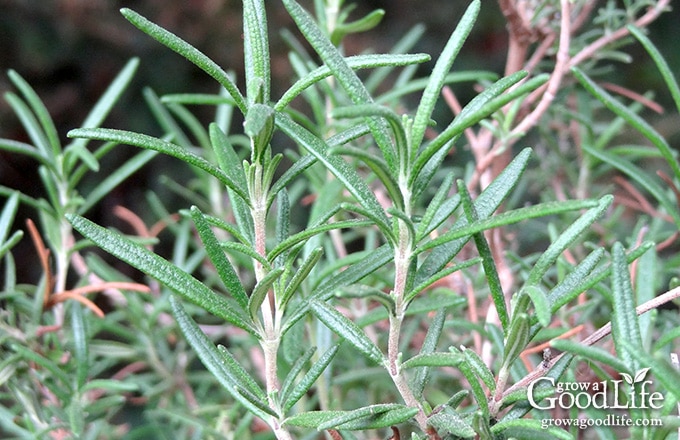
Benefits of Growing Rosemary Plants from Stem Cuttings
Instead of purchasing a new rosemary plant every year or starting new plants from seeds, try growing your own from stem cuttings. Some of the benefits of growing rosemary from cuttings vs. starting from seeds include:
- Earlier Harvest: A rooted rosemary plant from a cutting will mature quicker than a plant started from seed. Rosemary seeds tend to have low germination rates and take a long time to sprout and grow. A rosemary stem cutting will reach a usable size in just a few months, so you will be able to harvest rosemary sooner.
- Same as the Mother Plant: The rosemary plant you will grow from cuttings will be an exact clone of the mother plant and have the same flavor, disease resistance, and growth.
- Extra Plants for Free: A single plant can provide numerous cuttings without risking the health of the plant. So you can line your kitchen windowsill with several plants that will smell wonderful when you brush your hand against them.
How to Grow Rosemary from Cuttings
Here are steps to taking rosemary cuttings from an established mother plant and grow new rosemary plants in containers that can be moved outside in summer and indoors in winter.
Step 1: Select new shoots from the mother plant
Choose healthy stems with fresh growth. The younger shoots will have green stems that are flexible. Avoid older brown, woody stems.
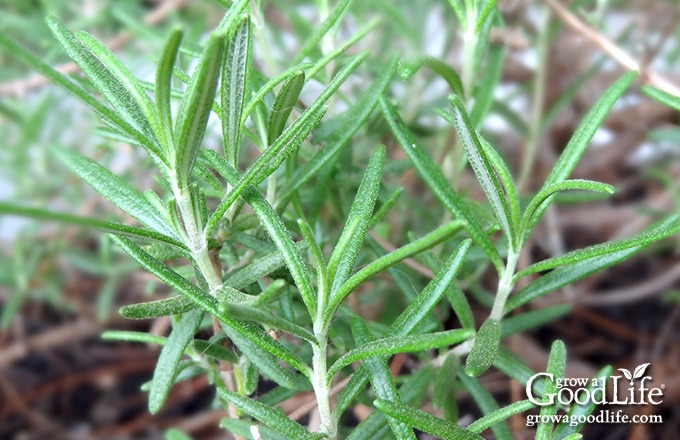
Step 2: Take stem cuttings
Use sharp scissors and snip the rosemary stem about 5 to 6-inches back from a fresh growing tip. Cut plenty of extra stems in case some fail to grow roots.
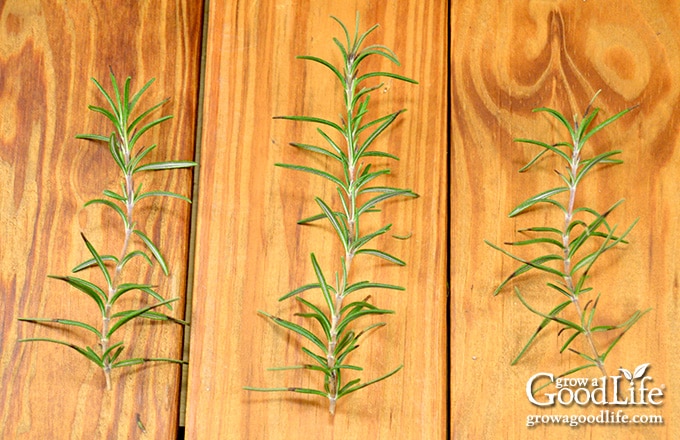
Step 3: Strip the lower leaves
Grasp your fingers around the stem, and gently strip off the lower 2-inches of needles from the stem of the rosemary cutting.
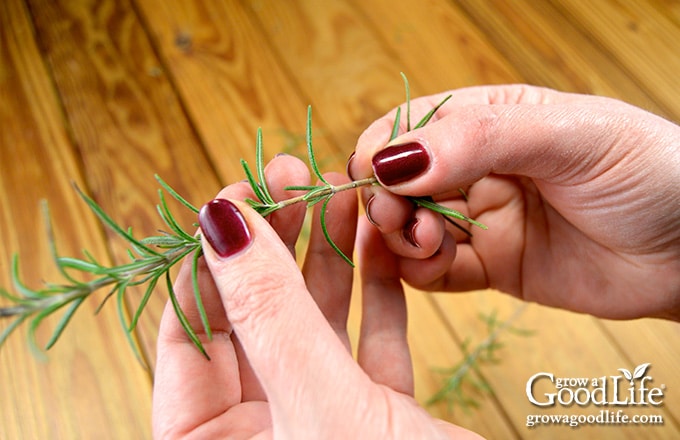
Step 4: Place cuttings in water
Stick the stems in a jar of water and place the jar in a warm place away from direct sunlight. Change the water every couple days, replacing with room temperature water. The fresh water provides dissolved oxygen and prevents the cuttings from rotting.
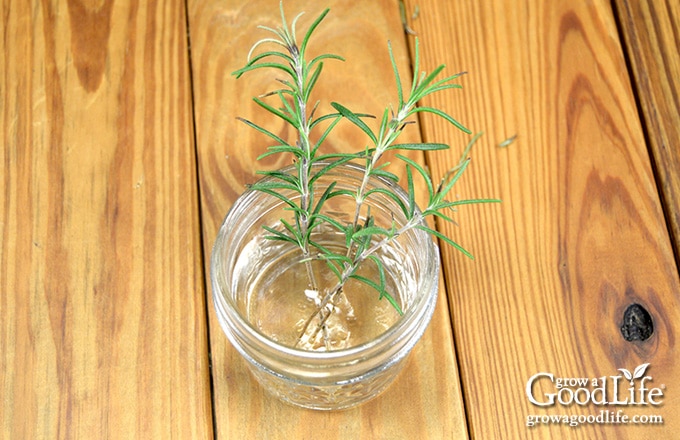
The rosemary stem cuttings should grow roots in a few weeks depending on the temperature. It can take longer in colder temperatures. After 4 to 8 weeks it should be apparent if the rosemary cuttings have survived. The cuttings that do not survive will be brown and shed needles. If your rosemary cutting is still alive, give it some more time.
Step 5: Pot up the stem cuttings once roots develop
Your rosemary cuttings are ready to place in soil when you see 4 to 6 roots on each stem that are at least 1/2-inch long. Use a sandy soil mix that drains well. Mix equal parts all-purpose potting soil and sharp sand. Or use cactus-potting soil. Use a sandy soil mix that drains well. Mix equal parts all-purpose potting soil and sharp sand. Or use cactus-potting soil.
Fill a 4-inch pot with slightly damp potting soil for each rosemary cutting. Use a pencil to make a 3 to 4-inch hole into the soil. Place the cutting in the hole with care to avoid damaging the roots. Cover gently and water thoroughly.
Place the newly potted rosemary plant in indirect light or in filtered sunlight until roots become established, and then move to direct light, at least 6 to 8 hours per day. Keep the potting soil moist until you see new growth.
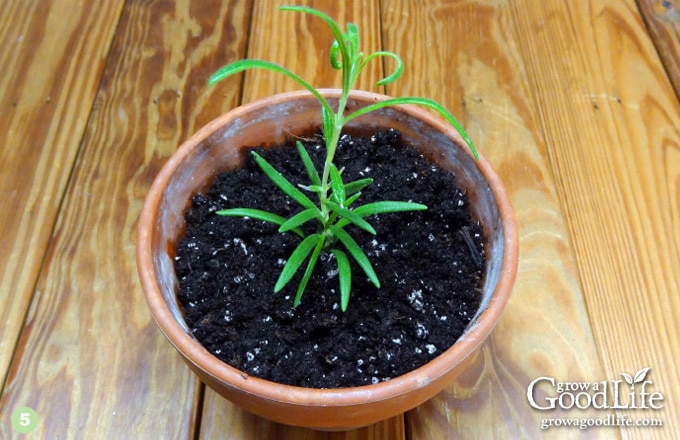
Let the new plants to put on some growth before harvesting. Once the plant is 6-inches tall, harvest by cutting stems as needed. New growth will continue forming on the stem. Rosemary grows slowly so don’t harvest more than 1/3 of the plant at one time.
How to Care for Rosemary Plants
Rosemary is a rather robust plant once it is established and growing. Here are some tips to keep your plant healthy and producing:
- Grow in a sunny location. Rosemary thrives in 6-8 hours of direct sun in the summertime.
- Water when the soil feels dry. Once established, rosemary likes to stay on the dry side. Allow top inch of soil to dry out between watering, and then water thoroughly.
- Re-pot as the plant gets larger and the roots fill the container. A rosemary plant that grows in a container can reach 1 to 3 feet high. Just keep transplanting to a larger container when the roots fill the pot.
- Prune rosemary frequently. The more you trim, the bushier the plant grows. Prune the plant after it flowers to keep it compact.
Tips for Growing Rosemary Indoors in Winter
Rosemary is native to Mediterranean climates so it prefers a hot, sunny, and humid atmosphere. Here are some tips for keeping your rosemary plants alive indoors during winter:
- Quarantine: If you have houseplants, it is a good idea to quarantine your rosemary plants when you bring them indoors. Keep the plants in a separate location for a while to be sure there are no hitchhikers, pests, or disease.
- Light: Locate your rosemary plants in a bright south-facing window. Alternatively, you can use grow lights and keep your plants happy during the winter months.
- Water: Try to keep the potting mix evenly moist. Over watering will cause the plant to rot. If the soil is too dry, the plant will wither and die. Water when the soil dries out at the surface and let the extra moisture drain.
- Temperature: Rosemary likes it a bit on the cooler side during the winter. Keep the plants away from heat sources and wood stoves. About 60 to 65 degrees is ideal.
- Humidity: Winter heating keeps us warm, but it also saps moisture from the air and drops the humidity. Compensate by misting your rosemary plant frequently, running a humidifier, or placing your rosemary plant on a tray of pebbles and water to increase the humidity around your plant.
- Pests and Diseases: Common pests for indoor rosemary plants are red spider mites, aphids, spittlebugs, and whiteflies. These pests suck on the plants and cause the foliage to wilt and dry up. Inspect your rosemary plants frequently for pests and control with organic insecticidal soap. Diseases such as root rot, powdery mildew, and mold are all signs of too much moisture and poor air circulation. Allow the top inch of soil to dry out between watering, and then water thoroughly allowing extra water to drain out of the bottom of the pot. Run a fan to improve air circulation around your plants.
This article was originally published March 23, 2015. It has been updated with additional information, new photos, and video.
You May Also Like:
Good planning is key to a successful vegetable garden
Whether you are new to growing your own food or have been growing a vegetable garden for years, you will benefit from some planning each year. You will find everything you need to organize and plan your vegetable garden in my PDF eBook, Grow a Good Life Guide to Planning Your Vegetable Garden.


I have bought one of those Christmas shaped rosemary trees and would like to use it for cooking but then replant outside here in the Phoenix AZ area. Is there a good time to do so? It still gets freezing here at night into winter but I have also left this in the pot in the past inside and it has died … the stems turned brown?
TS, Most established rosemary varieties are hardy to 20°F (zone 9). I would wait until warmer weather to transplant your rosemary plant outside. I have killed my fair share of rosemary plants over winter in the past. The key is to give them plenty of water and humidity. Here is a great article by my friend Amy at Tenth Acre Farm with some tips: https://www.tenthacrefarm.com/2014/08/the-secret-to-keeping-rosemary-alive-indoors/
Thanks for the tutorials. I have been trying to grow rosemary and I can’t wait to try this out.
Hi there. I just stumbled across your Rosemary advice and loved the way you have written it. I live in Canterbury in New Zealand and have grown and re-propagated Rosemary plants for over 40 years, so I’m keen to see more people doing it. Here, we have mild winters with snow on the ground for less than a month per winter and only a short season of frosts. Rosemary thrives in cold and when I lived nearer the mountains I had great healthy tasty plants, both prostrate and erect. As long as the ground temperature stays above minus 5 celsius (23 fahrenheit), you should have no problems allowing the plants to over-winter outdoors. Even a few really cold nights will make no difference… and you can still take delicious cuttings anytime.
Ijan
Thanks for the tips, Ijan. Our winters are too cold for rosemary to survive outside, but those who live in the US Hardiness Zones 8 and further south can grow rosemary year around. These bushes can grow 4 feet tall and spreads about 4 feet wide depending on the variety.
I’m in zone 7 and my rosemary has surved outside over 20 years. Will definetly try cuttings this year. Thanks for the info.
Ken, That is so cool that your rosemary survives outside from year to year. It must be huge! You should be able to grow a lot of plants from cuttings. We are in zone 5 and it is too cold for rosemary in winter.
This sounds like the way to go. I tried planting rosemary seeds and none germinated. Last year I managed to get one plant so I am going to try to propagate more plants from it. I think I will try rooting in water and also directly in soil.
Don, I have tried growing rosemary from seed too and it seem to take forever to grow to a good size. Propagating from cuttings is much faster. Let me know how you make out.
Thank you very much. I learnt alot from you.
Rosemarie never makes it through the winter here either. I need to root a few and try them indoors. Thanks for the great idea.
Great tutorial! I didn’t know you could propagate rosemary this way!
This is new to me — my ancient rosemary plant is dying and I was feeling sad about it. now I’m hoping I can at least keep a chunk of it.
Hi Rachel,
Thank you for enlightening us with these valuable tips propagating a Rosemary plant from stem cuttings at the Healthy, Happy, Green and Natural Party Blog Hop! I’m pinning and sharing!
Thanks for the great information. I did not know how to do this so your post has been very helpful.